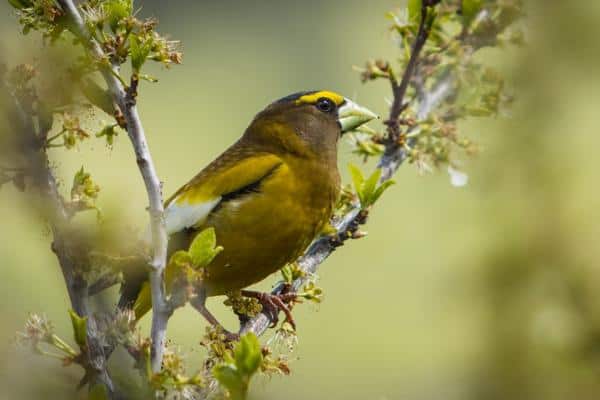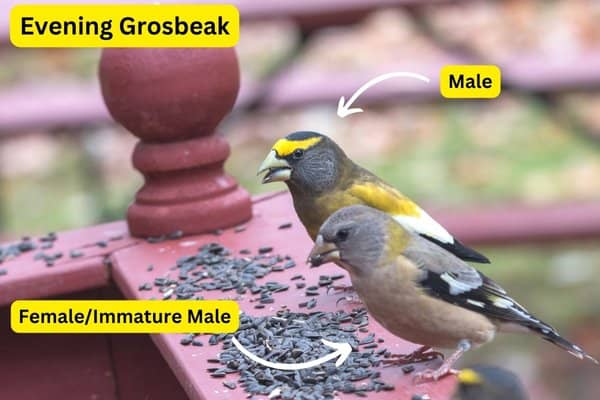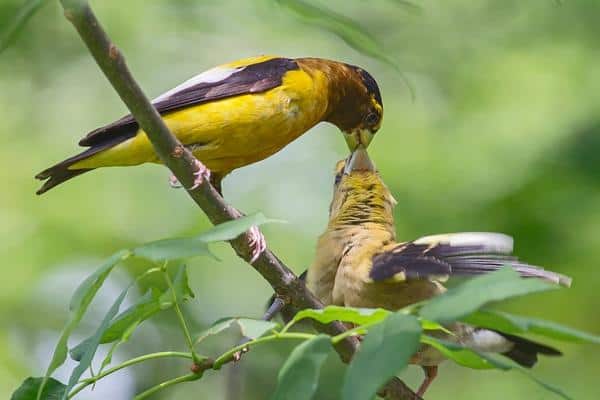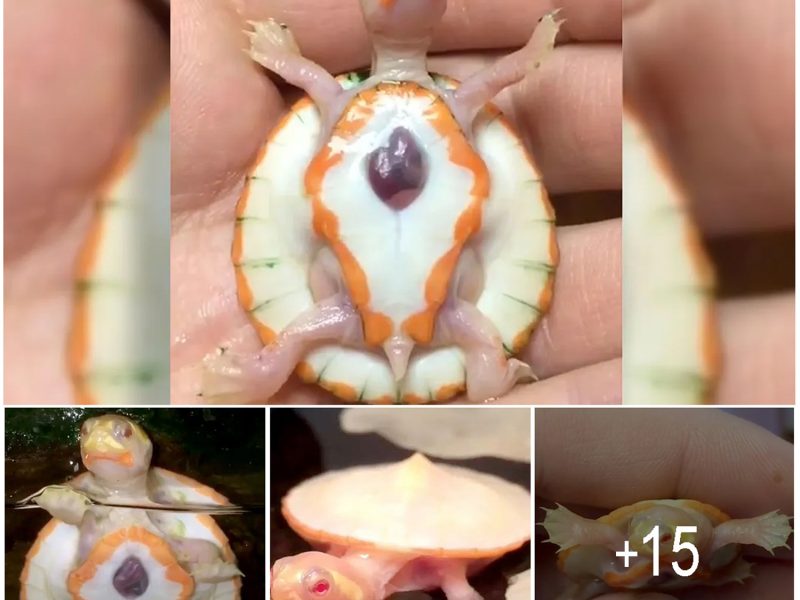Evening Grosbeaks are hardy finches that thrive in high altitude forests. Despite their tendency to keep to older forests, they are regular visitors to bird feeders in the winter, especially if you offer them sunflower seeds. These colorful, master seed crackers are beautiful songbirds that birdwatchers are always excited to see. Let’s learn a little about this species with 13 facts about Evening Grosbeaks.
13 FACTS ABOUT EVENING GROSBEAKS
1. THEY LIVE IN THE PACIFIC NORTHWEST, CANADA, AND MAINE.
Evening Grosbeaks’ primary range is across Canada and dips down into the Pacific northwest and Rocky Mountain regions of the United States. They breed as far south as Mexico, in high-elevation forested areas up to 10,000 feet. Historically, they were only found west of the Rocky Mountains, but began moving east in the late 1800’s early 1900’s. Each winter they pushed east a little further until arriving in New England by 1911. Today they are regulars around the Great Lakes and northeast, including Maine.
The expansion of some of their favorite trees the box elder and Manitoba maple, due to ornamental planting, may have been instrumental in their spread eastward.
2. MATURE FORESTS ARE THEIR FAVORITE HABITATS.

These finches prefer to live in high-altitude forests with mature conifer trees or mixed coniferous-deciduous forest that include spruce, fir, pine, aspen and oak. Older trees usually indicate a thriving old-growth forest ecosystem, which is safer and healthier than other younger forests. They choose mature forests over younger ones because older trees put more effort into producing seed each year. In the winter they spread to more urban and suburban areas.
3. SEEDS ARE THE MOST IMPORTANT PART OF THEIR DIET.

Take one look at an Evening Grosbeak’s thick bill and you’ll know it’s a seed-eating bird. It uses the powerful muscles behind its bill to break open the hardiest of seeds. That’s very useful in an environment where seeds are so abundant.
Trees have different ways they distribute seeds: via pods, cones, or fruit, etc. The gently curved bill of this finch is able to break open almost any outer shell to get at the meat inside.
4. THEY OFTEN APPEAR AT FEEDERS FAR OUTSIDE THEIR RANGE DURING THE WINTER.
Evening Grosbeaks are notorious for flying far from their native range during the wintertime. They are more likely to be seen in the northern U.S. states, but can show up almost anywhere, even as far south as Texas. It may depend on food supply in their typical range or other factors, but it’s hard to predict which winters they will show up in uncommon places.
But when they do wander out of range, they are known for visiting backyard feeders in flocks. Sunflower seeds are always a favorite. Platform feeders would be best, as their large size makes even tube feeder difficult to use.
5. THE MALE AND FEMALE HAVE DIFFERENT PLUMAGE

The plumage of many finch species differs between the male and the female, with males usually being more colorful. Evening Grosbeaks are no different.
The male of the species’ color patches are defined well. His breast and belly are yellow, while his wings, tail, and head are black. He has a solid white patch on the wings and a yellow patch on his forehead that stretches over the eyes.
Females and immature males share the same plumage and are more dull by comparison. Their head and back are gray with a pale, buffy chest and belly. Their black wings are marked with several white spots. Only a little yellow is present around the neck.
6. EVENING GROSBEAKS CHIRP INSTEAD OF SING.
Compared to other finches, Evening Grosbeaks are surprisingly non-vocal. They don’t have a regular song and males don’t sing complex melodies to woo females during the breeding season. Instead of singing, they communicate through a variety of single-syllable chirps which can be sharp or buzzy.
7. THEY HAVE SOME OF THE STRONGEST BEAKS OF ANY FINCH.

Their thick, conical beak and powerful muscles make cracking open seeds quick and easy. One Evening Grosbeak can break open and eat hundreds of seeds in a single day. Many seeds in their habitat of mature forests have quite hard shells that can even withstand forest fires. That doesn’t matter to this finch. It uses its powerful bill to chomp through them with ease.
Other songbirds that live in the same habitat such as the Common Redpoll and the Pine Siskin have beaks too delicate to crack some of the larger seeds. But they may follow Evening Grosbeaks as they forage and quickly swoop in and snatch seed scraps left behind.
8. THEIR FAVORITE TREES ARE BOX ELDERS.
Box elders are a type of maple tree which Evening Grosbeaks particularly favor and provide a lot of food. They may also be responsible for the increase in this bird’s population in the east around the turn of the 1900s.
After Canadian and American settlers in the northern prairies established homes and towns, they planted Box elders because of their rapid growth rate and ability to provide shade. This created a corridor of food and habitat for Eastern Grosbeaks to follow eastward.
9. MALES DO A MATING DANCE TO WOO FEMALES.
This quiet species of finch does not perform a song to attract his mate. Instead males opt to woo potential mates with gifts of food and dances. In a courtship dance, the male lifts his head and tail, spreads out and shakes his wings, and turns from side to side.
10. BOTH PARENTS WORK TOGETHER TO RAISE YOUNG.

The division of labor between a mated pair of Evening Grosbeaks is even. After a quiet courtship ceremony, the male defines a small nesting territory with tall trees. The female builds a small, saucer-shaped nest high in the tree out of twigs and grasses. She usually lines the nest with pine needles. Eggs are a pale blue or greenish blue with brown speckles.
After the chicks hatch, both mom and dad bring insects back to their hatchlings for up to two weeks. They grow so quickly that some pairs can have up to two broods in a single year.
11. THEY ARE GREGARIOUS AND LIVE TOGETHER IN FLOCKS.
Evening Grosbeaks don’t tend to be very territorial. In the winter they often forage together in flocks. In the spring and summer they separate into smaller groups or breeding pairs, and don’t usually expend energy chasing others away from their food source.
12. THEY EAT SEEDS, INSECTS, AND EVEN DRINK SAP.
Evening Grosbeaks were built to crack open seeds with ease, but their diet is more diverse than just one category of food. In the spring, they eat buds from trees and even drink maple sap. To get at it, they break small twigs and drink from the cut.
The summertime in the north abounds with plant and insect life, so they take advantage of their surroundings. Berries, such as snowberries or juniper berries, or fruits, like crabapples and cherries, are go-tos. Some can even dig out cherry pits with their tongues and spit them out before eating the fruit!
One creature they eat most often in the summer is spruce budworm larvae. They also consume aphids and caterpillars.
13. THEY ARE BECOMING LESS COMMON IN THE NORTHEASTERN U.S.
Their expansion into the eastern U.S. seems to have peaked right around 1980, and they have since been in decline in the northeastern states. Logging and development, disease outbreak and decline of spruce budworm populations may all be contributing. If climate change continues, balsam fir trees are expected to recede in New England which would be yet another reason for Evening Grosbeaks to move away from the area.

